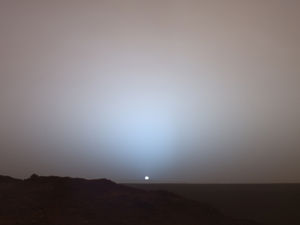Sunlight
The Sun is on average 228 million km away from Mars. Sunlight takes 13 minutes to travel from the Sun to Mars with a power of 589 W/m2. It is not as bright as on Earth (1367 W/m2).
As shown by the images transmitted by the various probes and rovers, the sky is caramel colored most of the time. At sunrise and sunset, the sky can be blue near the horizon, as per the Spirit photograph. This is due to sun scattering of other wavelength by the dust in the Martian atmosphere.
The Martian atmosphere does not filter sunlight as efficiently as on Earth, leaving too much UV ray and high energy particles to reach the surface. Life directly on the Martian surface is considered unlikely without additional shielding against UVs and cosmic radiation from the solar winds. Anearly warning system) may be useful for an eventual settlement.
The amount of usable energy on the surface is much lower than the solar constant due to the rotation of the planet and is also reduced the furter away you are from the equator due to the incident angle of the light at the surface. Reflection and absorption (albedo) in the atmosphere must be considered. On Earth, the annual usable energy per m2 is about 1000 kWh in Middle Europe and 2400 kWh in the Sahara.
Due to the dust, sunlight on Mars is usually fairly diffuse. It comes from many directions at once, rather than directly from the sun. Rather like an overcast day on Earth. This makes it harder to concentrate sunlight using reflectors.
Sunlight can be used for power generation by solar panels and for growing plants in greenhouses.
Facts and figures
"in the UK we receive an average power of about 125 Wm-2 whilst the Sahara Desert gets 250-300 Wm-2" [1]. With 24*365 hours per year, this results in an average usable energy per m2 and year of 1095 kWh in the UK and 2190-2628 kWh in the Sahara.
The Mars solar constant is 590 W/m3, while the Earth solar constant is 1350 W/m2. Mars gets about half the sunlight Earth does. The Martian atmosphere is dusty; the usable energy at the Mars equator may be about 1100-1300 kWh per year per m2, or somewhat like England or Northern Europe.
Psychological and physiological effects of sunlight
- The generally lower levels of sunshine may require the use of artificial lighting to treat seasonal depression disorder, as in commonly done in Northern countries on Earth.
- The lower lighting levels may affect plants and reduce their agricultural yield and rate of growth.
- What are the psychological and physiological effects of the permanent dim light on humans, animals and plants?







